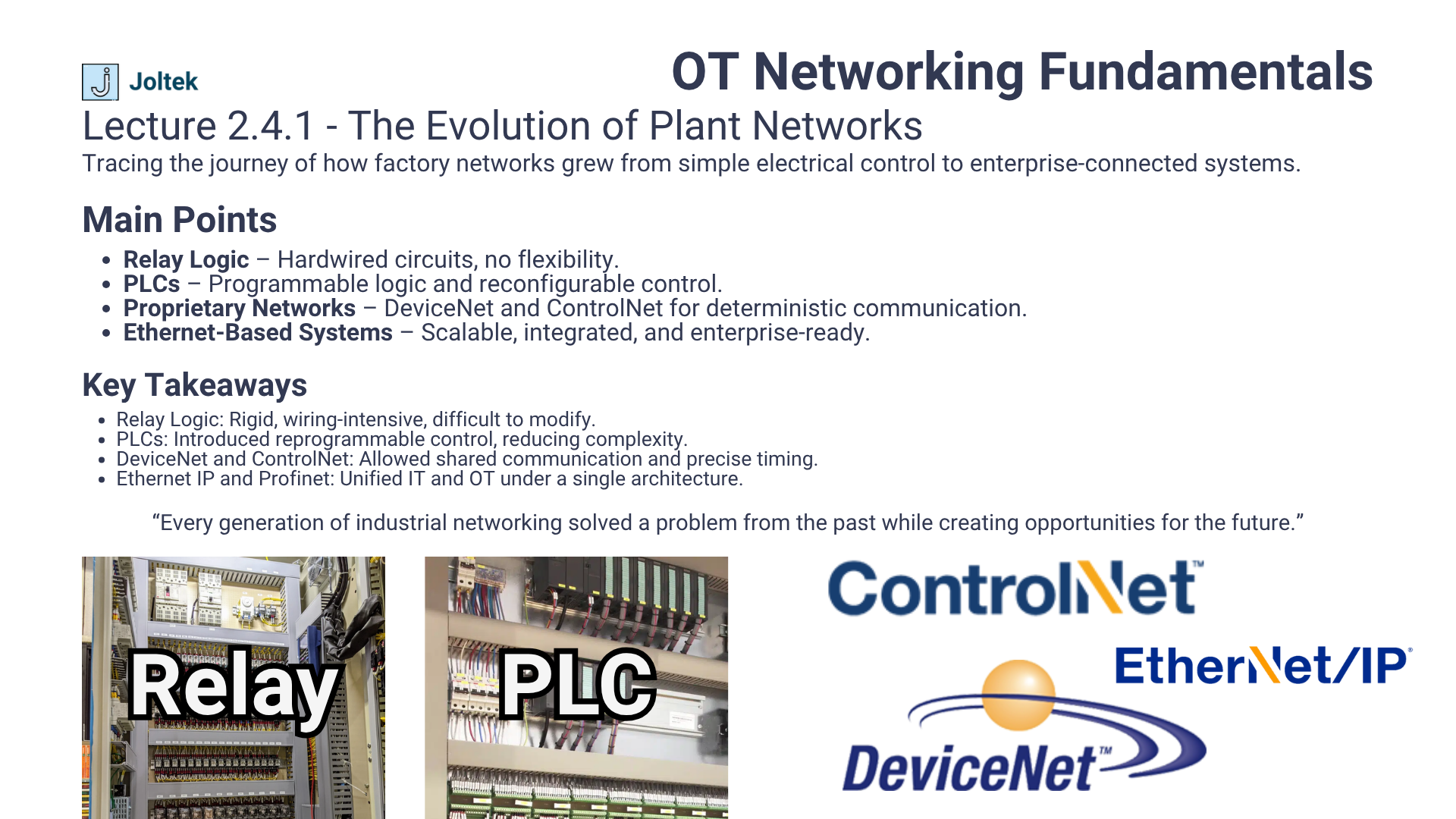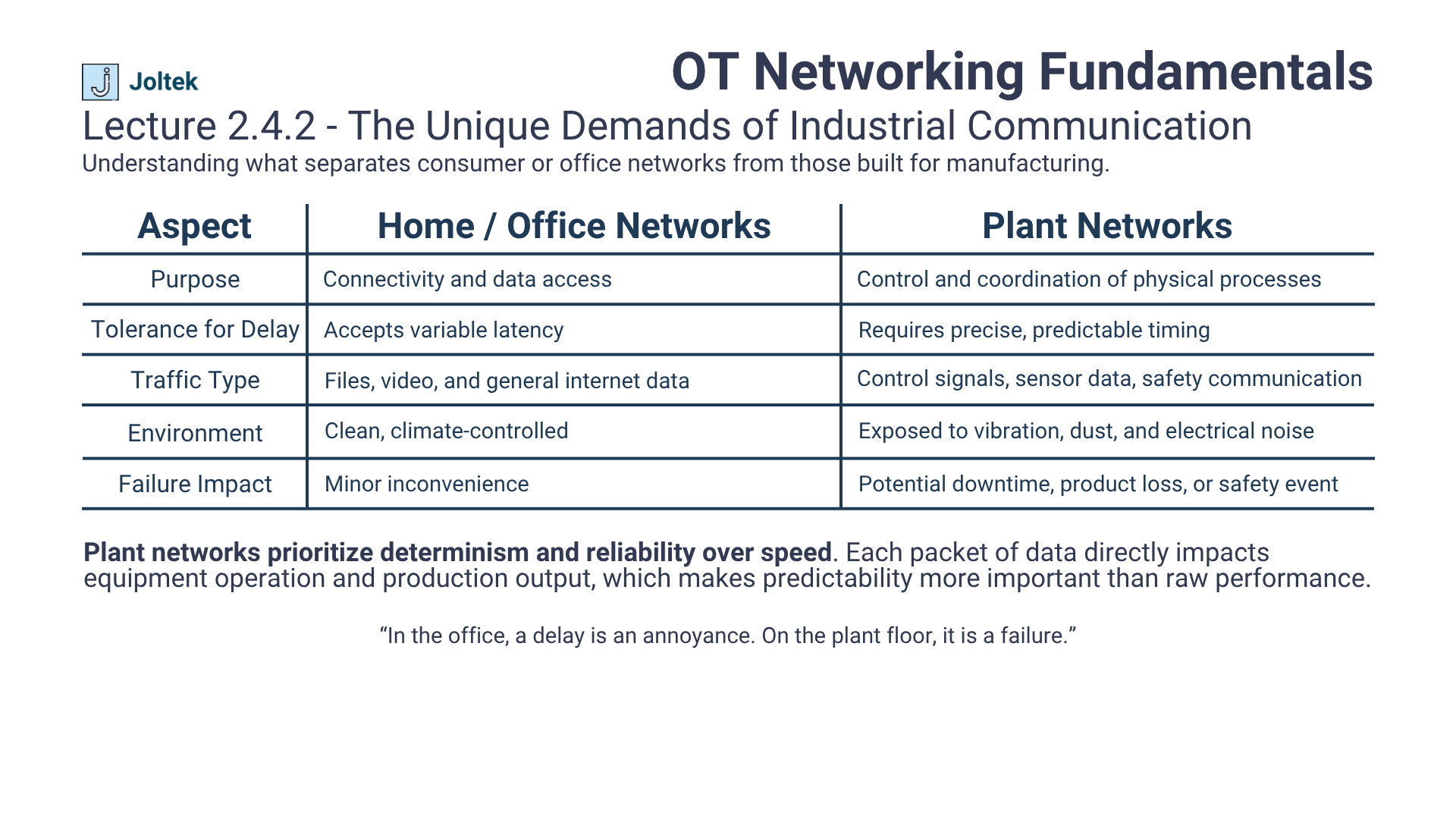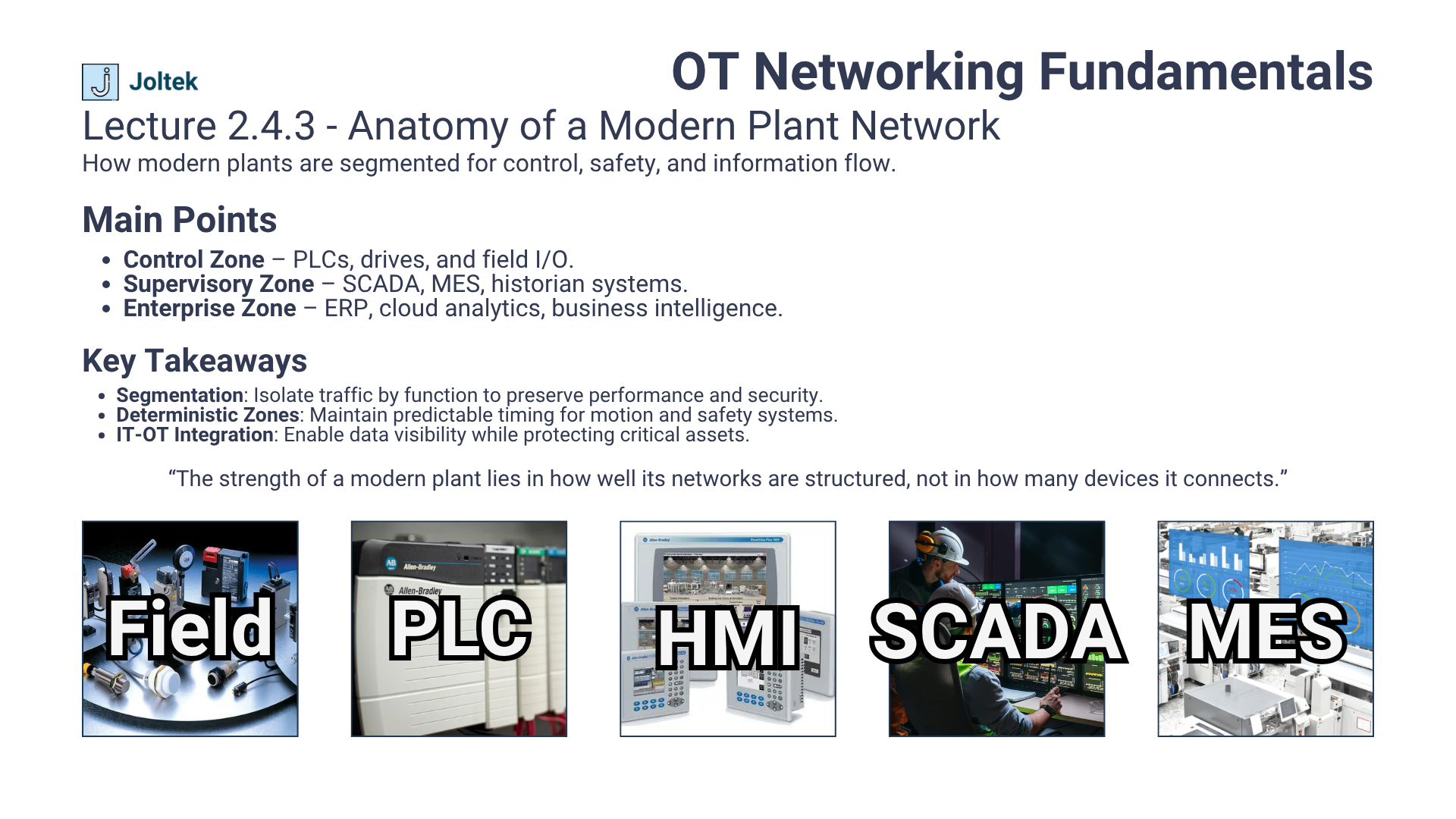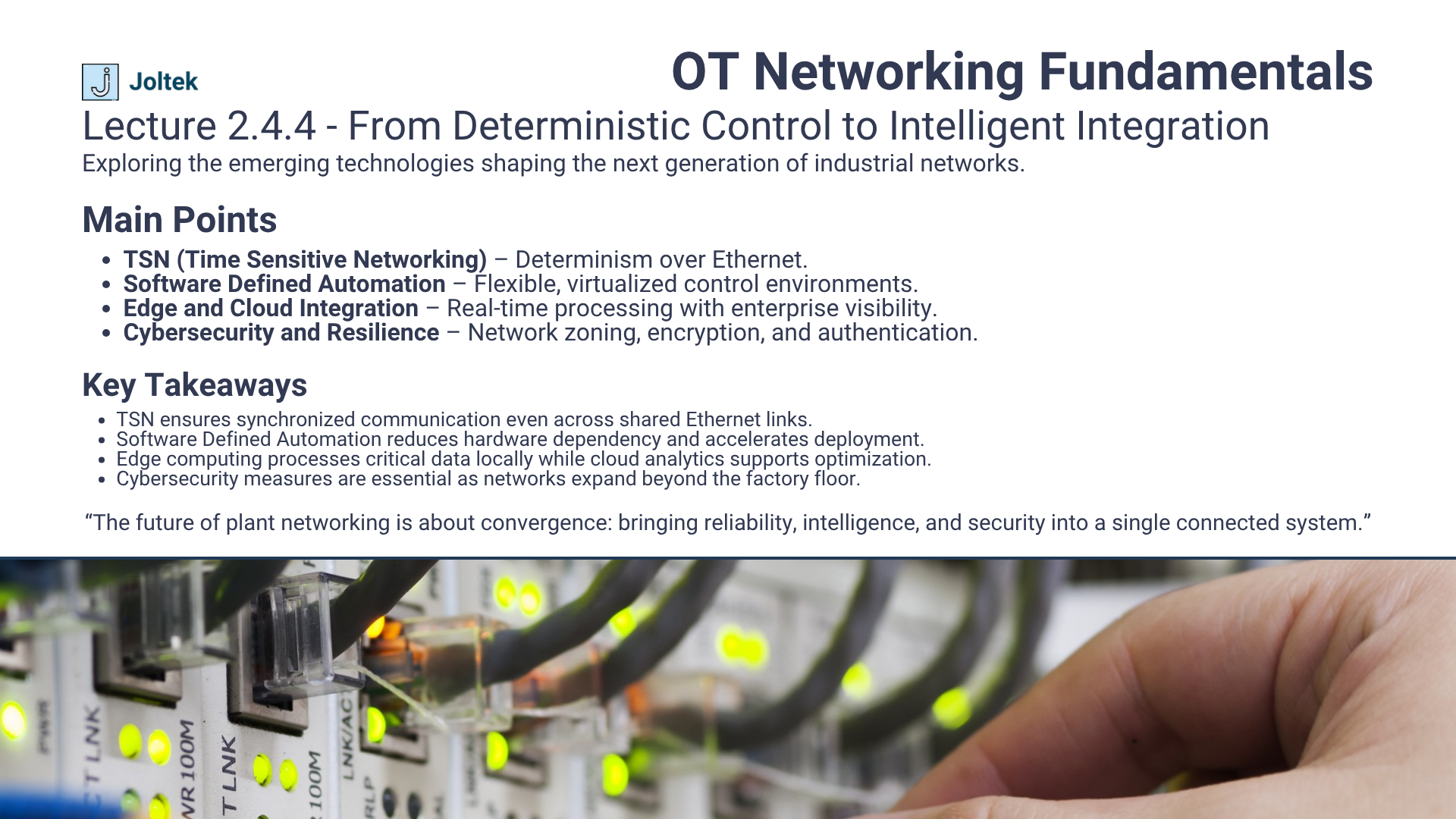Understanding how plant networks operate is one of the most important skills for anyone working in manufacturing, whether you are an engineer, a controls specialist, or an IT professional supporting production systems. The way data travels across the factory floor defines far more than efficiency. It determines the safety, reliability, and overall performance of the entire manufacturing process.
In consumer or office environments, a network is often treated as a utility. Devices connect, data flows, and occasional interruptions are tolerated without significant consequences. A brief delay in video streaming or a dropped call does not cause any harm. Inside a plant, however, the same delay could mean a conveyor misalignment, a rejected batch, or a shutdown of a high-speed line. The tolerance for error is almost nonexistent. Every packet of data has a purpose, and timing, accuracy, and consistency are non-negotiable.
Industrial networks evolved from a very different starting point than the networks found in our homes or offices. Early systems were built to control physical equipment, not to browse the web. The focus was on deterministic communication, meaning that every signal needed to arrive at a precise time. This requirement came from the nature of manufacturing operations, where motors, sensors, and actuators must work together in perfect sequence.
To understand how we reached the connected systems of today, it helps to trace the evolution of industrial communication. The earliest factories relied entirely on relays and hardwired control panels. Each change in logic required physical rewiring, which was time-consuming and limited flexibility. The introduction of Programmable Logic Controllers (PLCs) transformed this model by making logic software-driven rather than hardware-bound. PLCs allowed engineers to reprogram equipment, replicate logic across systems, and create the foundation for data-driven automation.
As manufacturing continued to evolve, these systems began to exchange information across multiple machines. The first communication protocols, such as Modbus, enabled basic data transfer between controllers and devices. Later, deterministic networks like DeviceNet and ControlNet addressed more complex requirements such as synchronization and motion control. Eventually, Ethernet-based architectures brought scalability and connectivity to new levels, connecting entire production lines to enterprise systems and cloud platforms.
Today, understanding plant networks means understanding this entire journey. It is no longer enough to wire a PLC and connect a switch. Engineers must design networks that are secure, deterministic where required, and flexible enough to support future integration. IT professionals, in turn, must understand the unique constraints of industrial environments, where uptime, isolation, and deterministic behavior outweigh bandwidth or convenience.
This evolution continues to shape how factories operate. For those seeking to explore how automation systems have matured and where they are heading, Joltek’s deep dive into automation in manufacturing provides valuable context. It outlines how control systems, communication layers, and industrial software all converge to create efficient, data-driven operations.
Plant networks are not just a technical layer beneath production. They are the foundation upon which modern manufacturing stands. Understanding their history, design, and purpose is the first step toward building systems that are not only connected but also dependable, secure, and ready for the challenges of the future.

Before modern automation and networking existed, factory control systems were built on hardwired electrical logic. Every motor, valve, and sensor was connected through relays and contactors arranged in large panels. Engineers designed systems by physically wiring each connection, which meant that even the smallest logic change required hours of manual labor. These systems were reliable but rigid. Once a circuit was installed, flexibility was nearly impossible, and diagnosing a failure meant tracing every wire by hand. In environments with hundreds of signals, that could bring production to a standstill.
The introduction of the Programmable Logic Controller completely transformed industrial control. When the first PLC, the Modicon 084, was introduced in the late 1960s, it replaced miles of hardwired relays with software-based logic. Engineers could now modify sequences directly through programming rather than rewiring control cabinets. This shift drastically reduced commissioning time, simplified troubleshooting, and allowed manufacturers to adapt production lines quickly to new requirements.
Beyond reprogrammable logic, PLCs also introduced the ability to monitor input and output states in real time. This brought diagnostic capabilities that were previously impossible, letting engineers visualize system performance, detect failures, and reduce downtime. Over time, PLCs became the foundation for nearly every control architecture in manufacturing, from packaging systems to high-speed motion control. The new challenge that emerged was how to connect these intelligent controllers to other devices and systems across the plant floor.
As automation advanced, the next logical step was enabling data exchange between controllers and the equipment they managed. Sensors, drives, and instruments were becoming more sophisticated, producing information that could improve control accuracy and operational visibility. To unlock that potential, engineers needed a way to send and receive structured data efficiently.
This is where communication protocols such as Modbus entered the scene. Developed in the late 1970s, Modbus became one of the first and most widely adopted industrial communication standards. It worked by transferring data through registers, which could represent analog values, digital signals, or configuration settings. Each register stored a piece of information that the PLC could read or write, allowing parameters like speed, torque, or frequency to be adjusted remotely.
This concept was revolutionary because it allowed for more intelligent and flexible control without the need for new wiring. For example, an operator could modify a motor’s speed reference directly through software rather than by replacing components or adjusting physical hardware. It also made it possible to collect real-time process data for analysis and reporting.
Even today, Modbus remains relevant. Many modern drives, instruments, and PLCs continue to include Modbus support because of its simplicity and reliability. Despite being decades old, it provides an accessible bridge between legacy and contemporary systems, especially in facilities that integrate older assets with newer Ethernet-based networks.
The foundation of plant networking began with a need for smarter and more configurable communication. The emergence of Modbus marked the beginning of a new era, where data no longer stayed isolated within a control cabinet but started to flow across machines, enabling visibility, optimization, and the first steps toward connected manufacturing.
As automation systems grew more complex, engineers needed better ways to connect sensors, motors, and control devices without filling panels with endless wiring. Before the introduction of industrial communication networks, each input and output required its own dedicated wire between the field and the controller. The result was large control cabinets, long installation times, and challenging maintenance. The introduction of DeviceNet simplified this entire process by allowing multiple devices to share a single communication cable.
DeviceNet fundamentally changed how engineers approached wiring and system design. It used a communication bus that allowed multiple devices to be linked together on one network segment. This structure, known as daisy chaining, enabled connections from one device to the next in a continuous loop, eliminating the need for every field signal to return directly to the control panel. Each device on the network was assigned a unique address so that the controller could identify and communicate with it individually.
This new approach brought several key benefits. Wiring time was reduced significantly, panels became less crowded, and system expansions could be completed more easily. Adding a new sensor or motor no longer required running a new cable all the way back to the controller. Instead, technicians could connect it to the nearest existing node and configure the address in software. It was a major step toward the flexible and modular design philosophy that dominates industrial automation today.
However, DeviceNet also introduced new challenges. Since devices shared the same cable, addressing conflicts could occur if two components were assigned the same identifier. Cable faults could bring down entire sections of the network, and troubleshooting required understanding how data moved across the bus. Debugging a DeviceNet issue often meant checking terminations, verifying power distribution, and reviewing communication diagnostics. Despite these complexities, DeviceNet marked an important step toward networked control and laid the foundation for even more advanced systems that would follow.

While DeviceNet focused on simplifying wiring and connectivity, manufacturing environments also needed networks capable of high-speed and time-critical communication. This led to the introduction of ControlNet, a protocol designed specifically for deterministic control. Determinism, in practical terms, means that data is transmitted at predictable intervals with guaranteed timing. It ensures that each control update occurs exactly when it is expected, which is essential for coordinated motion, safety systems, and high-speed production lines.
Imagine a conveyor system where products move between multiple stations. Each conveyor segment is driven by a separate motor controlled by a servo drive. These drives must synchronize perfectly so that each product transitions smoothly without collisions or gaps. On a non-deterministic network, data packets might experience slight timing differences due to congestion or random network behavior. In everyday internet applications, such as streaming a video, that variation goes unnoticed. On a production line, it can cause serious mechanical issues, damaged equipment, or wasted product.
ControlNet addressed this challenge by introducing scheduled and repeatable communication cycles. The network guaranteed that every device would receive updates at fixed time intervals. The communication pattern was organized and synchronized across the entire system, allowing precise coordination between controllers, drives, and sensors. This made ControlNet ideal for high-performance motion control and complex manufacturing processes where timing precision was critical.
The development of ControlNet represented a major leap toward predictable and reliable industrial communication. It demonstrated that the key to high-speed automation was not just faster hardware but also networks designed around timing and reliability. For those looking to understand how these systems evolved and how they connect to modern architectures, Joltek’s guide on control system modernization strategy explores how legacy communication methods continue to influence today’s industrial designs.
Proprietary networks such as DeviceNet and ControlNet filled a vital gap in manufacturing history. They offered the first real solutions for simplifying connectivity while ensuring deterministic control. This era established the principles of predictability and reliability that remain central to industrial networking today.
As manufacturing systems became more complex and global connectivity grew in importance, the industry began transitioning away from closed, proprietary networks toward open, Ethernet-based communication standards. These new architectures allowed automation systems to communicate using the same foundational technology as office and enterprise networks, creating an unprecedented level of scalability and integration across operations.
Ethernet IP and Profinet became the two defining technologies that bridged traditional automation and modern IT infrastructure. They introduced significant advantages, including higher data throughput, standardized cabling, and support for a wide range of devices from multiple vendors. For the first time, engineers could connect sensors, drives, controllers, and even supervisory systems using a common physical and logical network layer. This opened the door to interoperability and vendor-neutral design, something that earlier generations of proprietary networks could not provide.
The primary tradeoff of these Ethernet-based systems was that they were not inherently deterministic. Unlike ControlNet, which scheduled communication cycles to guarantee precise timing, Ethernet IP and Profinet relied on speed and bandwidth to achieve near-deterministic behavior. In most applications, this was more than sufficient. The incredible processing power of modern controllers and switches allowed networks to deliver updates fast enough for motion control, process automation, and real-time data collection. The result was a system architecture that balanced performance, flexibility, and scalability.
Beyond speed, Ethernet simplified installation and maintenance. Standard cabling meant that technicians could use readily available connectors and diagnostic tools. Faults could be detected faster, and network status could be monitored from both the control and IT sides of the organization. This greatly reduced downtime and increased the overall visibility of system health. It also made integration with higher-level software systems such as MES and SCADA platforms far easier, paving the way for connected manufacturing ecosystems.
With Ethernet-based systems came a new set of responsibilities for engineers. Devices that once communicated over proprietary protocols now required IP addresses, gateways, and defined network subnets. This change blurred the line between traditional control engineering and IT networking, creating the need for cross-disciplinary expertise. Engineers found themselves managing concepts such as VLAN segmentation, managed switches, and IP conflicts alongside ladder logic and process control.
Assigning IP addresses to field devices fundamentally changed how industrial networks are designed and maintained. It introduced the possibility of large, hierarchical architectures that spanned from the factory floor to enterprise systems. This connectivity brought remarkable opportunities for data collection and analytics but also new layers of complexity. Network segmentation became essential to prevent congestion and to maintain predictable performance, especially for time-critical control traffic.
The move to Ethernet also bridged the gap between OT and IT. Manufacturing systems could now exchange information directly with enterprise platforms, allowing data to flow from machines to MES, SCADA, and even cloud environments. This visibility enabled better decision-making, more efficient production scheduling, and improved quality control. However, it also expanded the attack surface of industrial networks. Cybersecurity, once a minor concern in isolated control systems, became a major focus. Protecting production assets from external threats required new strategies, including network zoning, firewalls, and strict access control policies.
As plants became more connected, the distinction between IT and OT began to fade. Teams that previously worked independently were now required to collaborate closely to maintain both operational continuity and data security. Ethernet was not just a new communication layer; it redefined how manufacturing organizations approached connectivity, management, and risk.

For those seeking to understand how to design and secure these converged architectures, Joltek’s service on IT and OT architecture integration offers insight into the frameworks and best practices that support reliable and secure communication across the enterprise.
Ethernet transformed plant networks from isolated automation systems into interconnected environments that link machines, people, and data. This evolution marked the beginning of enterprise-connected manufacturing, where IT-grade management and cybersecurity practices became essential to industrial success.
Designing a plant network in a modern manufacturing environment requires more than technical skill. It calls for strategic planning, collaboration between disciplines, and a deep understanding of both operational and informational needs. The purpose is not simply to connect devices but to create a communication framework that supports safety, reliability, and scalability across the entire facility.
The strongest network designs begin with logical segmentation. This involves dividing the network into clearly defined zones that serve specific purposes such as control, safety, and information. The control zone handles real-time operations that demand precise timing, connecting PLCs, drives, and I O modules. The safety zone operates independently to protect personnel and equipment, ensuring that emergency systems remain isolated and unaffected by other traffic. The information zone connects supervisory and analytical systems such as SCADA, MES, and historian platforms that aggregate data for visibility and reporting. By separating these layers, engineers reduce interference, improve fault containment, and maintain predictable performance even as systems expand.
Managed switches and VLAN configurations are the foundation of this structure. They allow engineers to isolate and prioritize network traffic so that time-critical control data remains unaffected by non-essential communication. In fast production lines or motion control systems, even minor latency can create errors or product loss. Proper segmentation and prioritization ensure that every packet of data reaches its destination exactly when needed.
Deterministic segments are another essential element in modern designs. These segments are dedicated to communication tasks that must occur in exact time intervals, such as synchronized drives or robotic motion. Achieving this consistency requires careful planning, redundant network paths, and industrial-grade switches configured to support quality of service rules. The combination of structured traffic control and physical redundancy provides both speed and reliability in high-demand environments.
Good engineering practice also depends on documentation. Every network should have clear diagrams, consistent naming conventions, and a logical addressing scheme that makes future modifications easier to manage. Maintenance strategies such as routine audits, switch backups, and firmware updates help sustain network integrity over time. A plant network is never static; it evolves with the facility, and proper documentation ensures that future teams can build upon the foundation without introducing unnecessary complexity.
The future of plant networking is being shaped by technologies that merge industrial reliability with the scalability of information technology. One of the most important innovations is Time Sensitive Networking, often referred to as TSN. This standard allows Ethernet communication to maintain precise timing while carrying different types of traffic on the same physical network. It provides the reliability of deterministic control with the flexibility to support additional applications such as video monitoring and analytics.
Another emerging concept is software defined automation. This approach separates control functions from fixed hardware, allowing engineers to deploy virtual controllers, scale resources, and reconfigure systems quickly through software. It creates a more adaptable environment where production can be optimized without replacing physical components. When combined with edge computing, software defined automation brings greater intelligence closer to the equipment, reducing latency and improving responsiveness.
Hybrid cloud architectures are also redefining how plant networks are designed. By combining local control with cloud-based analytics, manufacturers gain access to advanced data processing and visualization tools without compromising real-time operations. Cloud integration supports predictive maintenance, cross-site coordination, and enterprise-level decision-making. However, it also increases the importance of cybersecurity. Engineers must consider data protection, authentication, and network segmentation from the earliest design stages to maintain both performance and safety.
The essence of modern plant networking is balance. It is about maintaining deterministic performance where timing matters most while embracing scalability and intelligence where flexibility adds value. These advancements align closely with the goals of digital transformation, allowing manufacturers to improve visibility, optimize processes, and unify their operations across multiple facilities.
Modern plant networks demand foresight, collaboration, and a disciplined approach to cybersecurity. They are the foundation of connected manufacturing, where machines, systems, and people operate within one intelligent, reliable, and secure ecosystem.

Plant networks have progressed from the simplicity of relay-based control systems to the complexity of interconnected architectures that unite information and operational technologies. What was once a system of wires and contactors has become a digital framework that supports data-driven decision-making, real-time monitoring, and seamless coordination across the plant floor. Each stage of this transformation, from the introduction of the Programmable Logic Controller to the rise of Ethernet-based communication, represents a step toward smarter and more adaptable manufacturing.
Modern manufacturing depends on professionals who understand both electrical and networking principles. Engineers must know how to design control logic while also managing switches, subnets, and communication protocols. They must grasp how data moves across systems just as clearly as they understand how a motor starts or how a sensor behaves. This blend of skills ensures that every element of the production process communicates with precision and reliability.
Understanding the history and evolution of plant networks is more than an academic exercise. It is essential for maintaining operational safety, optimizing performance, and achieving scalability. A strong network design enhances reliability, supports predictive maintenance, and creates visibility that extends from the plant floor to enterprise systems. Without a clear strategy, however, these same networks can become fragile, exposing operations to downtime, inefficiencies, and cybersecurity threats.
Now is the right moment for manufacturers to evaluate their existing network architecture and modernization strategy. Legacy systems may continue to function, but they often lack the flexibility and security required for modern operations. Conducting a structured assessment can help identify risks, prioritize upgrades, and align network capabilities with long-term goals. For organizations seeking guidance in this area, Joltek’s expertise in IT and OT architecture integration offers a proven framework for modernization and secure connectivity.
The ability to understand and design plant networks is now a defining capability of successful manufacturing organizations. It determines how safely, efficiently, and intelligently a facility can operate. By developing the literacy to navigate both the electrical and digital layers of production, engineers and leaders prepare their plants for a future where connectivity, resilience, and data-driven performance define success.